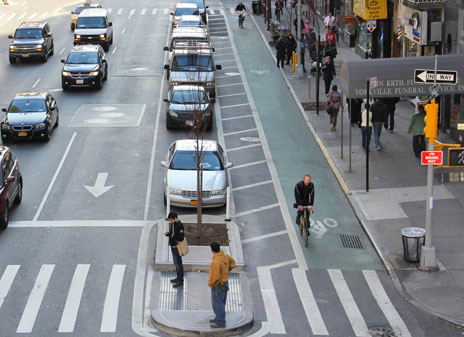Stories about aggrieved Manhattan car owners in search of a parking spot are evergreen. On an island of 1.6 million residents, there's only so much street space to go around -- that's never going to change. Parking a car was a pain in 1997, and it's a pain today.
But the city has changed since 1997. Two things Manhattan has today that it lacked 20 years ago are a bike-share system, introduced in 2013, and protected bike lanes, which have been spreading since 2007. The aggrieved car owner story hasn't been the same since.
Instead of getting angry quotes about the evil Parking Violations Bureau or merciless meter maids, reporters can stick a mic in the face of someone behind the wheel and ask about bike lanes. This type of segment was all over the airwaves six or seven years ago then faded away, before NY1's Michael Scotto revived the genre with this week's "No Parking Anytime" series.
Scotto sets the tone with Upper West Side car owner Ben Bowman, who tells us about the time he threatened a rival for a parking space with a tire iron: "I said, 'You can have this spot, but you're taking a beating when you get out.'" We're supposed to sympathize with him, except 77 percent of Manhattan households can't relate because they don't own cars. (Bike Snob has a great scene-by-scene takedown of the segment.)
We learn in part one that protected bike lanes and bike-share stations replaced 2,330 on-street parking spaces in Manhattan south of 125th Street. It culminates with a shot of a block-long bike-share station that "holds more than 65 bikes, but at the expense of about nine parking spots."
In part two, Scotto looks at the high cost of garage space in Manhattan for "middle-class New Yorkers" -- again skipping over the fact that the overwhelming majority of Manhattanites don't own cars -- and we learn that the supply of off-street parking south of 60th Street has dropped by nearly 18,000 spots since 1998:
In 1998, there were 810 lots and garages south of 60th Street, with 112,826 spaces. By last year, there were just 643 facilities and 95,000 spots, a decline of 16 percent. This as Manhattan's population surged by more than 100,000 people.
These are some interesting stats on parking. If you take away the motorist grievance and add a bit more context, the numbers speak volumes.
There are 2,330 fewer on-street parking spaces in Manhattan to make room for bike lanes and bike-share (DOT cautions that this is based on curb footage and overcounts actual parking spaces, but that's okay), and the number of off-street parking spaces in the central business district has fallen by tens of thousands in the past two decades.
Meanwhile, Manhattan has...
- More people: From 2000 to 2015, Manhattan gained 108,000 residents. The rent may be high, but those 108,000 additional residents are keeping housing prices from becoming even less affordable in the rest of the city.
- More employment: The number of jobs rose by about 130,000 between 1998 and 2012.
- Fewer traffic injuries and deaths: From 2009-11 to 2013-15, the annual average of serious traffic injuries and fatalities on Manhattan streets fell 12 percent, from 683 to 601.
These relationships are no coincidence -- cars take up too much space and parking gums up the works for everything that makes New York City tick. You can't have abundant housing if every apartment has to come with a parking space, and you can't have good streets for walking, biking, and transit unless you're willing to reduce the number of curbside parking spots.
More housing, more jobs, safer streets, less parking. Let's keep it up.






